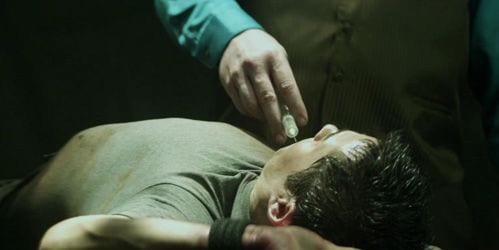
If you’re a fan of genre cinema, especially of the horror variety, or if you read much published analysis of contemporary movies, or even if you’ve only talked about them with your mother from time to time, chances are you’ve stumbled across the term “torture porn”. The phrase has a reactionary quality that tends to stifle discussion before it begins by stacking the deck against the films in question: pornography, clearly, cannot be art, or at least most filmmakers would feel slighted to have their work categorized as such.
Critic David Edelstein first slapped films like Saw and Hostel with the term, calling attention to the gruesome, protracted nature of their scenes of violence. He didn’t really make an argument, but “torture porn” sort of says it all, doesn’t it? There are a lot of hoary old discussions to bring up again here: the treatment of women in film, whether violence can be art, etc. Yesterday’s news. Watch a good giallo film (I recommend Sergio Martino’s All the Colors of the Dark) and we’ll have lunch.
What still interests us about this discussion of torture in today’s thrillers — and how this finally all ties into The Devil’s in the Details — is how torture really functions in a narrative. Americans got to talk about torture again just recently with Zero Dark Thirty, whose script stayed pretty cagey about how critical its scenes of torture were to driving the overall narrative. The drawn-out scenes of pain in The Devil’s in the Details, on the other hand, purport to be the impetus of the plot, yet ultimately serve as more of a visceral accenting of the offscreen action.
Much of the movie really seems to be taking place offscreen, as — minor spoilers — war vet and embattled grocery store manager Thomas Conrad (Joel Mathews) ends up spending most of his screentime in a sort of nondescript, fluorescent-lit bunker. Through a rather improbable coincidence, he’s been drawn into convoluted, Rube Goldberg-ian scheme to help transport a great deal of drugs across the Mexican border, which he’ll accomplish by pleading members of his family, all seemingly at one level or another of the law enforcement game, to go along with the plan while men in suits inflict distressing amounts of pain on him.
Once you step back for a moment, none of this makes much sense. Why do the gangsters continue to torture Conrad while his family members are already participating in the scheme? There are some brief snags, mostly involving unexpected firefights, and none of which the audience actually witnesses: Conrad just moans in pain as thugs apply the latest innovation in agony to his person. The camerawork does its best to distract from the sheer pointlessness of these scenes by panning around the room, which results in some very odd moments like a lingering shot of a wheelchair in the corner — an abandoned bit of backstory? It’s never mentioned again.
You might well wonder how Conrad could really be an interesting hero, confined and impotent as he is throughout the ordeal. Here to prod at his inner psyche is Ray Liotta as Dr. Robert Michaels, an Army-approved psychologist and former Navy SEAL, apparently only to provide an excuse for Liotta to squeeze in the movie’s only real action scene. The script seems to have awkwardly taken a psychological drama, shredded it up and mixed it in with a locked room thriller, for all the coherence that the flashbacks of Conrad in Michaels’s office have. An unfortunate number of clichés are scattered throughout these scenes in which Michaels tries to help Conrad through his PTSD, including pill addiction, an estranged wife and daughter, and the requisite daddy issues. None of these, save for his skeptical father, ultimately figure in the main drug plot.
Most of the time, the picture seems to be headed in a quite different direction than where it ultimately ends up. The various flashbacks (in which Conrad’s wife and daughter are always seen in flat, subjective POV shots), the blurred, dreamy nature of the bunker scenes, and the backwards-counting “Week 22” / ”Week 15” / ”Week 7” captions during scenes in Dr. Michaels’s office all seem to point to some sort of Memento-like revelation: perhaps Conrad’s family is dead, or he’s imagining his whole ordeal, or he has been in a coma ever since the war. All of these would probably make more sense than the simultaneously confusing and underwhelming twist that ultimately concludes the film.
The DVD’s lone extra, a ten-minute “Behind the Scenes” featurette, largely consists of actors recounting plot points. Emilio Rivera, who plays the villainous Bill Duffy, seems hilariously puzzled as to how the story fits together, while Ray Liotta appears tired and unsure of how to compliment the movie. Several cast members compliment writer-director Waymon Boone, who does not speak in the featurette himself but is seen giving direction to the actors in on-set footage. Mathews seems to think the movie is really about PTSD, which would indeed be a worthy subject for a thriller, but the scenes relating to Conrad’s mental state are too distorted to deliver effective drama.
Featuring one of the most unpleasant scores you’ll ever hear (think Penderecki doing a THX promo), The Devil’s in the Details bewilders and repulses the viewer: goals it shares with many a psycho-thriller, but it fails to tell a discernible story or to make its scenes of pain even visually engaging. In moviemaking, those are cardinal sins.

![Call for Papers: All Things Reconsidered [MUSIC] May-August 2024](https://www.popmatters.com/wp-content/uploads/2024/04/all-things-reconsidered-call-music-may-2024-720x380.jpg)



